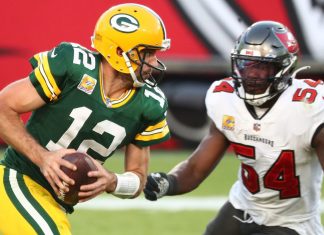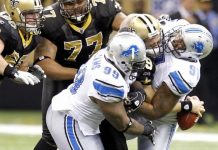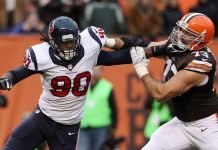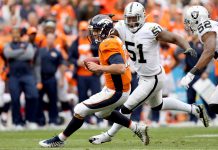NEW YORK (AP) The memorable moments and teams in NFL history can be summarized by a word or phrase such as the ”Steel Curtain” or ”America’s Team.”
And the NFL has had more than its share of those moments and teams through the years. Even though a list such as this could be virtually endless, here’s a look at some of the top NFL nicknames, including players, plays, teams and even stadiums.
Team Nicknames
”Aints” – Refers to the struggles of the woeful New Orleans Saints in the 1980 season when they were the first team to finish 1-15 in a season. Fans registered their disgust by wearing paper bags over their heads at the games. But the name also refers in general to the team’s struggles for most of its first 30 years.
”America’s Team” – Love `em or hate `em, it’s the Dallas Cowboys. And despite having not won a Super Bowl since the 1995 season, their popularity nationwide hasn’t waned.
”Steel Curtain” – A Pittsburgh twist on the Cold War phrase ”Iron Curtain” for the Steelers’ stellar defense of the 1970s, which paved the way for four Super Bowls in a six-season span. Pretty much every dominant Pittsburgh defense since then receives the same honor.
”Legion of Boom” – Pun on the ”Legion of Doom” group of villains from DC Comics. The Seahawks’ strong defensive teams of the past decade helped win Super Bowl 48 and nearly repeated the next year. Its most prominent members included Richard Sherman, Earl Thomas, Kam Chancellor, Bobby Wagner and K.J. Wright.
”Purple People Eaters” – The bruising Minnesota Vikings’ defensive line from the late 1960s through the `70s. Members included Hall of Famers Alan Page and Carl Eller, plus Jim Marshall. If not for going 0-4 in Super Bowls, the group likely would be more celebrated.
”Greatest Show on Turf” – The high-scoring St. Louis Rams led by Kurt Warner, Marshall Faulk and Isaac Bruce during the late 1990s and early 2000s. These Rams played in a dome on turf and piled up the yards and points as they won Super Bowl 34 and fell just short to New England two years later.
”Hogs” – Washington’s big, beefy offensive line (by the standards of the day) during the first Joe Gibbs coaching era in the 1980s and early `90s that helped lead the way to three Super Bowls. Some male fans at RFK Stadium would wear dresses and fake pig snouts to honor their Hogs.
”The Smurfs” – With help from the Hogs, Washington’s group of wide receivers – Gary Clark, Alvin Garrett and Charlie Brown – who were all under 6-foot, also played a key role in the team’s success. The name refers to the popular cartoon series in the 1980s featuring small blue characters.
”Monsters of the Midway”- The fearsome defense of the Chicago Bears. First used in the early 1940s, then applied to the iconic 1985 team led by Hall of Famers Richard Dent and Mike Singletary that rolled to the Super Bowl. And it even was used for last season’s team led by Khalil Mack, which went 12-4 and won the NFC North.
”New York Sack Exchange” – The defensive line of the New York Jets in the early 1980s, including Mark Gastineau, Joe Klecko and Marty Lyons. But like all Jets teams in the past 49 years, this group failed to reach the Super Bowl.
Player Nicknames
”Concrete Charlie” Chuck Bednarik – Hard-hitting Hall of Famer played both center and linebacker for the Eagles. The six-time All-Pro made a game-saving tackle to preserve Philly’s 1960 NFL title win over Green Bay – the only playoff loss for the Vince Lombardi-led Packers.
”The Assassin” – Defensive back Jack Tatum was known for his fierce and intimidating hits for the Oakland Raiders in the 1970s, including one that left Patriots wide receiver Darryl Stingley paralyzed after a hit in a preseason game in 1978.
”The Mad Bomber” – Daryle Lamonica got this nickname after being traded from the Buffalo Bills to Oakland in 1967 and he unleashed a deep passing game with the Raiders for the next several seasons. He was the quarterback in the infamous ”Heidi” game in 1968 as he led the Raiders to a 43-32 comeback win over the Jets. Finished with more than 19,000 yards passing and 164 touchdowns.
”The Minister Of Defense” – Packers and Eagles defensive lineman Reggie White. White became an ordained minister long before the end of his Hall of Fame career that included being an eight-time All-Pro and two-time NFL Defensive Player of the Year. He finished with 198 sacks and 33 forced fumbles.
”Slingin”’ Sammy Baugh – This Hall of Famer was a key part of the early passing boom in the NFL in the late 1930s and early `40s for Washington. Not just a ”slinger,” he amazingly led the NFL in passing, punting and interceptions in 1943. Baugh finished his career with 31 interceptions and was voted to the NFL’s 75th Anniversary team.
”Megatron” – Lions standout wide receiver Calvin Johnson, who had more than 700 catches, 11,000 yards and 83 touchdowns. The three-time All-Pro retired at 30 after the 2015 season and a nine-year career. The nickname comes from the main villain in the ”Transformers” film franchise.
”Prime Time” – Hall of Fame cornerback and return man Deion Sanders. He was one of the most dominant cornerbacks of all time. At his peak, Sanders took away half of the field because teams wouldn’t throw near him. Yet he still managed 53 interceptions. The six-time All-Pro also knew how to find the end zone with 22 career TDs (nine pick-6s, six on punt returns, three on kickoff returns, three receiving and one on a fumble return). Sanders is the only player to appear in both a Super Bowl and a World Series.
”Broadway Joe” – The one and only Joe Namath, who of course backed up his famous guarantee as he led the New York Jets past the Colts to win the third Super Bowl 16-7. The Hall of Famer was the first QB to pass for more than 4,000 yards in a season and finished with 27,663 yards and 173 TDs.
Elroy ”Crazylegs” Hirsch – This Hall of Fame halfback for the Rams led the NFL in scoring and receiving for the 1951 champions. His nickname comes from his unique running style, which didn’t stop him from finishing with 60 touchdowns in his career.
Dick ”Night Train” Lane – Hall of Famer who had 68 interceptions in 14 seasons, mostly with the Chicago Cardinals and Detroit Lions in the 1950s and `60s. Lane got the nickname from teammates from the then-popular song ”Night Train” during his first training camp with the LA Rams in 1952.
Assorted Nicknames:
”Holy Roller” – With the Oakland Raiders trailing the San Diego Chargers by six late in a September game in 1978, Raiders quarterback Ken Stabler was leading a drive in the red zone in the final minute. Under pressure, he was ruled to have fumbled the ball forward, though it appeared intentional. Teammates Pete Banaszak and Dave Casper also advanced the ball while bobbling it, with Casper falling on it in the end zone for the winning touchdown. The rules were later changed to prevent this type of play from occurring late in games.
”Black Hole” – Nickname for a section in the south end zone of Oakland Coliseum, which has some of the most rowdy fans in the league, who are also known for their distinctive outfits that seem like they belong in outer space. Whether even the Las Vegas strip is ready for that in 2020 is another matter. The biggest Black Hole for the team has been its record of late, with only one winning season since 2002.
”Dawg Pound” – Nickname for the rabid Cleveland Browns fans who are known for wearing dog masks, barking, and, in the old days throwing dog biscuits and worse at the opposing team. The Dawg Pound may make some big noise in 2019 as the Browns are a trendy pick to go to the playoffs.
”Cheeseheads” – What fans of the Green Bay Packers are called. The most fervent supporters of the team from the dairy-producing state wear hats with foam cheese on top, no matter the temperature or the weather.
”Immaculate Reception” – One of the most famous and controversial plays in NFL history is nearly 50 years old. The Steelers were trailing the Raiders 7-6 and were down to their last play with under a minute remaining in a 1972 AFC Divisional playoff game. Under pressure, Terry Bradshaw launched a deep pass from his 30-yard line to ”Frenchy” Fuqua, who was at the Raiders 35. The pass deflected backward and Franco Harris reached down to his shoe tops and caught it. Harris went down the left sideline for a touchdown, and an unlikely 13-7 Steelers win. Which player deflected the pass, either Fuqua or Raiders safety Jack Tatum, and whether the play should have counted, has been debated ever since. The victory was a catalyst for the Steelers’ dynasty in the 1970s.
A lesser-known fact about the game: It was the first playoff win in Steelers history.
”Helmet catch” – Little-used receiver David Tyree took Eli Manning’s desperation heave and pinned the pass against the top of his helmet while fighting off Patriots defensive back Rodney Harrison late in Super Bowl 42. The 32-yard gain in the fourth quarter allowed the Giants to score the go-ahead touchdown and upset the Patriots, who entered 18-0 and were trying to complete the only 19-0 season in NFL history.
”Hail Mary” – Credit Hall of Famer Roger Staubach with this. After the Dallas Cowboys quarterback completed a late, 50-yard pass to Drew Pearson to win a playoff game at Minnesota, Staubach said: ”I guess you could call it a Hail Mary. You throw it up and pray.”
”No Fun League” – How critics of the NFL refer to the league when it is seen as stuffy, out of touch, and clamps downs on the players’ attempts at self-expression. Not that such a moniker has hurt NFL recognition.
”The Greatest Game Ever Played” – The 1958 NFL championship game between the Baltimore Colts and New York Giants was the first overtime game in league history. Alan Ameche’s short touchdown run gave the Colts a 23-17 victory. The thrilling game was televised nationally and is credited with sparking the NFL’s rise in popularity.
”Ice Bowl” – The 1967 NFL championship game between the Cowboys and Packers. One of the most accurate nicknames in sports history with a temperature of minus-14 and a wind chill of minus-49 at Lambeau Field, it was the coldest NFL game ever recorded. The Packers won 21-17 on Bart Starr’s QB sneak in the final seconds. It was also the second-to-last game that Vince Lombardi coached with Green Bay.
”Music City Miracle” – Only eight days into the 2000s, the Bills found a new way to lose a postseason game. This time it was in Nashville (aka Music City) during wild-card weekend. Leading 16-15 after a field goal with 16 seconds left, the Bills kicked off to the Titans. Tight end Frank Wycheck threw a cross-field lateral to wide receiver Kevin Dyson and he raced 75 yards down the left sideline for the touchdown in a 22-16 win. The Titans eventually advanced to their only Super Bowl to date, and came within a yard of possibly tying it on the final play against ”The Greatest Show on Turf.”
—
More AP NFL: https://apnews.com/NFL and https://twitter.com/AP-NFL
25% Bonus via Western Union
















